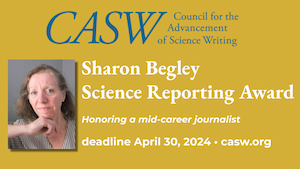By Amy Maxmen
Sunday morning began as sweetly as the late Lou Reed’s until Maryn McKenna stepped in. Leave it to “scary disease girl” to scare a captive audience with a panel on pandemics. Grab a raisin danish and tune into a talk about a new SARS-like virus sweeping Saudi Arabia and cholera in Haiti.
Glenn Morris, the director of the Emerging Pathogens Institute at the University of Florida in Gainesville, began by clearing up the misconception that most emerging diseases are new. Most of them come from ancient pathogens that are re-emerging because of changes in us (such as growing older and more susceptible to infection) and to our environment (such as clearing forests for houses). In Kipling’s day, for example, case fatality rates from cholera were as high as 40%. Today those rates have gone down, but the diarrheal disease still leads to some 120,000 deaths annually.
Lawsuits about the United Nations’ introduction of cholera into Haiti are ongoing, but Morris said there’s little mystery about where to place blame. Isolates from the bacteria underlying the disease, Vibrio cholera, are clonal, which suggests a single common source. “The evidence is extremely strong that there was an asymptomatic carrier [a UN worker] from Nepal,” who introduced the disease into a country that hadn’t seen a case of cholera for at least 100 years.
Morris explained how epidemiologists can track the spread of this strain throughout rivers and reservoirs in Haiti by sequencing DNA from Vibrio cholera. It even appears to have reached Mexico and possibly Cuba. “Pathogens move across borders,” he said. “Diseases come along with people.” It’s not a comforting thought just before we all crowd onto planes later today and this week.
Gregory Gray, the director of the Global Pathogens Laboratory at the University of Florida, stepped up to talk about the new coronavirus called Middle East Respiratory Syndrome (MERS-CoV) that has killed dozens of patients, mainly in Saudi Arabia, since April 2012. Gray has joined other researchers in learning which animals carry the bug. Although its cousin, SARS, has been traced to bats, pathogens often find new animal vectors when the come to new countries, Gray said. This summer, investigators suggested that camels could be the middlemen. Gray related this host hopping to West Nile virus, in which baby alligators here in Florida became a hotbed for viral replication.
Gray also defended Saudi Arabia from criticism that it was not taking the threat of a MERS outbreak seriously enough. Last month, international health officials had begun to worry about the spread of MERS during the Hajj, an annual pilgrimage that draws millions of Muslims to Saudi Arabia. However, Gray said, “My Saudi colleagues are acutely aware,” educating people, sharing information, and setting up tertiary care centers with diagnostic tests. He said the reason for delays from the Saudi Ministry of Health has to do with “litigation and lawyers” rather than apathy. “Saudi ministers have been deceived in their partnerships with research institutions,” he explained. In the past, he said, international researchers have patented viruses and published research findings based on outbreaks in the country, and this time around the Saudi government wants control over intellectual property. He said that these viral patents are used as the basis for diagnostic tests and vaccines, excluding others from the market and driving up costs.
Morris seconded the notion with regard to the lack of funding for research and development into tools to fight cholera and other infectious diseases. He then put in a plea for state and federal public health departments who exist to monitor re-emerging diseases, but whose budgets have been dismantled for the past decade.
.png)

